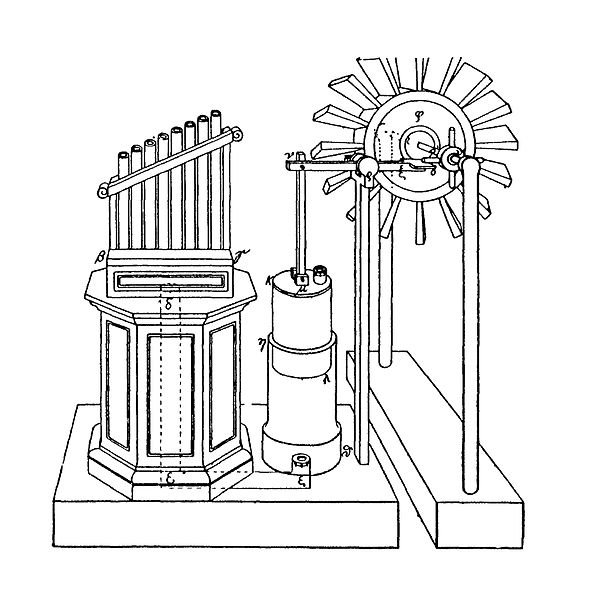Incredible Ancient Machines Invented By Hero Of Alexandria – An Engineer Far Ahead Of His Time
Ellen Lloyd - AncientPages.com - Little is known about Hero of Alexandria except that he was a remarkable ancient engineer far ahead of his time.
He invented several sophisticated machines that demonstrate his vast knowledge of mechanics.
Hero also called Heron, was a Greek mathematician. The date of his birth remains uncertain. Some authorities place his birthday early 150 BCE in Ptolemaic, Egypt. Other scholars date his birth to be 250 CE in the late Roman Empire.
As a student, Hero spent most of his time in the Library at the University of Alexandria. He loved to be in the library with a vast collection of books.
Hero of Alexandria was strongly influenced by the writings of Ctesibius of Alexandria. It is possible he was a student of Ctesibius. When older, he taught mathematics, mechanics, and physical science at the University of Alexandria.
He wrote many books and he used them as texts for his students, and manuals for technicians, and were written in Greek, Latin and Egyptian.
One of his amazing inventions is the so-called "The 'philosopher's stone' of Heron" that "changed" one liquid into another, for example, water into wine.
It consisted of an airtight vase of water which, at the top, had a tubular opening where water entered and reached the bottom and of an airtight vase of wine which, in the middle, had a tap in a siphon shape.
The two vases were connected by an intermediate small tube that entered the bottom and reached close to their top. When a certain amount of water was poured into the first vase, the air inside went through the intermediate tube to the second vase pushing out an equal amount of wine. (The tube arrangement did not allow the mixing of liquids," ('Heron, Pneumatics, A 14').
The hero is credited with the authorship of several manuscripts including Automata, the Pneumatica, the Dioptra, the Catoprica, and the Mechanica.
Hero invented a number of fascinating machines.
Standing on the shoulders of giants, it is believed that Hero studied the works of Archimedes and Vitruvius, as well as Ctesibius.
Most historians agree that some of the inventions included in Hero's manuscripts were, in fact, first created by others.
However, today it is very difficult to determine which invention was his. Therefore, for convenience's sake, most of the machines are simply referred to as "Hero's."
For example, Hero of Alexandria came up with a new invention that depended on the mechanical interaction of heat and water.
He invented a rocket-like device called an aeolipile. It used steam for propulsion. Hero mounted a sphere on top of a water kettle.
A fire below the kettle turned the water into steam, and the gas traveled through the pipes to the sphere. Two L-shaped tubes on opposite sides of the sphere allowed the gas to escape, and in doing so gave a thrust to the sphere that caused it to rotate.
In the book The Pneumatics of Hero Of Alexandria, Bennet Woodcroft, Professor of machinery in University College London lists all of Hero's inventions.
Below is just a selection of some of the machines he invented.
Hero's windwheel used the energy of passing gusts of wind to make an organ play. Unlike his steam engine, this invention did not require any great technical prowess or mechanical plays, but it did apparently require his unique insight.
It should be added that there are not any records of wind-powered machines before Hero came along.
According to the history of vending machines "Hero of Alexandria invented the first coin-operated vending machine dispensing holy water.
Hero's holy water vending machines could be found in temples across the land. These vending machines allowed each member to receive an equal allotment of holy water without requiring the presence of the priest. Hero's vending machines operated on an open valve system. When a coin was placed in the slot of the vending machine, it would rest on a platform. The weight of the coin would push the platform down, opening a valve, and dispensing a consistent trickle of holy water.
Hero's coin-operated holy water vending machines inspired the creation of many other vending machines lending to a financial gain."
This device used both heat and pneumatics to open a set of temple doors. To open the doors, the priest lit a fire on the altar, heating the air within and causing it to expand. This expansion in volume forced water out of the sphere and into the bucket, which moved downwards under the extra weight. This bucket was connected to a rope coiled around a spindle and, as the bucket moved downwards, this spindle revolved, making the doors open.
The first water pumps were probably designed by Ctesibius, as Heron frequently mentions his earlier works in his treatise. The force pump was later widely used in the Roman world for fighting fires.
He was not just a brilliant engineer. He was also an accomplished mathematician and theoretician.
He came up with the basics of what is now known as Fermat's principle. He described a principle of reflection, which stated that a ray of light that goes from point A to point B, suffering any number of reflections on flat mirrors, in the same medium, has a smaller path length than any nearby path.
As a mathematician Hero came up with the first approximation in Greece of a number's square root.
Today, his name is most closely associated with Heron's Formula for finding the area of a triangle from its side lengths. The imaginary number, or imaginary unit, is also noted to have been first observed by Hero while calculating the volume of a pyramidal frustum. He also wrote a number of books on mathematics, including Metrica.
It is almost certain that Hero taught at the Musaeum which included the famous Library of Alexandria because most of his writings appear as lecture notes for courses in mathematics, mechanics, physics, and pneumatics.
Although the field was not formalized until the 20th century, it is thought that the work of Hero, his automated devices, in particular, represents some of the first formal research into cybernetics.
He was very much an engineer and scientist far ahead of his time.
Written by - Ellen Lloyd – AncientPages.com
Copyright © AncientPages.com All rights reserved. This material may not be published, broadcast, rewritten or redistributed in whole or part without the express written permission of AncientPages.com
More From Ancient Pages
-
 Neanderthals Are Not The Only Species Whose Dentition Is Characterized By The Possession Of Thin Enamel
Archaeology | Jan 19, 2023
Neanderthals Are Not The Only Species Whose Dentition Is Characterized By The Possession Of Thin Enamel
Archaeology | Jan 19, 2023 -
 Explorer Discovered A Lost Underground World Beneath Big Sur In North America – But Why Cannot Anyone Else Find It Now?
Featured Stories | Feb 12, 2019
Explorer Discovered A Lost Underground World Beneath Big Sur In North America – But Why Cannot Anyone Else Find It Now?
Featured Stories | Feb 12, 2019 -
 Entrance To An Unexplored Ice Age Cave Discovered Near Engen!
Archaeology | Aug 4, 2023
Entrance To An Unexplored Ice Age Cave Discovered Near Engen!
Archaeology | Aug 4, 2023 -
 Unexplained Historical Mass Disappearances – Where Did They Go? – Part 2
Featured Stories | Jun 4, 2019
Unexplained Historical Mass Disappearances – Where Did They Go? – Part 2
Featured Stories | Jun 4, 2019 -
 Nammu: Sumerian Goddess Who Got The Idea To Create Mankind In The Image Of Gods
Featured Stories | Apr 1, 2019
Nammu: Sumerian Goddess Who Got The Idea To Create Mankind In The Image Of Gods
Featured Stories | Apr 1, 2019 -
 Struggle To Get Mail On Time Has Lasted More Than 5,000 Years – Part 2
Featured Stories | Jul 31, 2017
Struggle To Get Mail On Time Has Lasted More Than 5,000 Years – Part 2
Featured Stories | Jul 31, 2017 -
 Seshat: Goddess Of Astronomy Aligned Sacred Monuments To The Stars Long Before Imhotep
Egyptian Mythology | Mar 15, 2018
Seshat: Goddess Of Astronomy Aligned Sacred Monuments To The Stars Long Before Imhotep
Egyptian Mythology | Mar 15, 2018 -
 Mysterious Lost Civilization Of Tiahuanaco – Uncomfortable Truth About One Of The World’s Oldest Cities
Civilizations | May 24, 2020
Mysterious Lost Civilization Of Tiahuanaco – Uncomfortable Truth About One Of The World’s Oldest Cities
Civilizations | May 24, 2020 -
 Sun: Highest Cosmic Power Worshiped By Ancient People And Represented By Deities
Featured Stories | Apr 1, 2019
Sun: Highest Cosmic Power Worshiped By Ancient People And Represented By Deities
Featured Stories | Apr 1, 2019 -
 A Well-Preserved Lararium Shrine Discovered At Pompeii
Archaeology | Oct 10, 2018
A Well-Preserved Lararium Shrine Discovered At Pompeii
Archaeology | Oct 10, 2018 -
 2,000-Year-Old Poorly Preserved Mummies Unearthed Near Saqqara’s Pyramid of Djoser
Archaeology | Jul 3, 2019
2,000-Year-Old Poorly Preserved Mummies Unearthed Near Saqqara’s Pyramid of Djoser
Archaeology | Jul 3, 2019 -
 500 Million Year-Old Fossils Solve A Centuries-Old Evolutionary Riddle
Archaeology | Nov 7, 2022
500 Million Year-Old Fossils Solve A Centuries-Old Evolutionary Riddle
Archaeology | Nov 7, 2022 -
 6,300 Years Old Golden Artifact Unearthed At Solnitsata ‘The Salt Pit’ Prehistoric Settlement
Archaeology | Nov 23, 2015
6,300 Years Old Golden Artifact Unearthed At Solnitsata ‘The Salt Pit’ Prehistoric Settlement
Archaeology | Nov 23, 2015 -
 Baby God Hermes Started His Life As A Liar And Trickster
Featured Stories | Dec 25, 2020
Baby God Hermes Started His Life As A Liar And Trickster
Featured Stories | Dec 25, 2020 -
 Remarkable Archaeological Discoveries Made Near Bratislava, Slovakia
Archaeology | Oct 28, 2023
Remarkable Archaeological Discoveries Made Near Bratislava, Slovakia
Archaeology | Oct 28, 2023 -
 A Stone Age Child Buried With Bird Feathers, Plant Fibers And Fur Investigated In Finland
Archaeology | Nov 2, 2022
A Stone Age Child Buried With Bird Feathers, Plant Fibers And Fur Investigated In Finland
Archaeology | Nov 2, 2022 -
 Stunning Ancient Roman Artifacts And Three Shipwrecks Discovered Underwater Off The Coast Off Alexandria, Egypt
Archaeology | Nov 26, 2017
Stunning Ancient Roman Artifacts And Three Shipwrecks Discovered Underwater Off The Coast Off Alexandria, Egypt
Archaeology | Nov 26, 2017 -
 Modern Pesticide Accelerates Corrosion Of Ancient Roman Bowl
Archaeology | Oct 6, 2022
Modern Pesticide Accelerates Corrosion Of Ancient Roman Bowl
Archaeology | Oct 6, 2022 -
 How Did Sargon Become The Most Powerful Ruler Of Mesopotamia?
Featured Stories | Apr 3, 2020
How Did Sargon Become The Most Powerful Ruler Of Mesopotamia?
Featured Stories | Apr 3, 2020 -
 Extraterrestrial Visit Recorded On Stone: They Came From The Stars
Featured Stories | May 4, 2014
Extraterrestrial Visit Recorded On Stone: They Came From The Stars
Featured Stories | May 4, 2014






